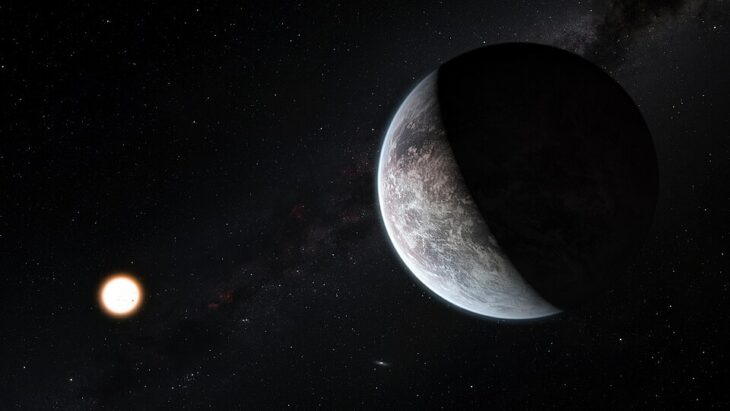Astronomers give types of planets around other stars, or exoplanets, several fun names that are variations on planets in our solar system. For example, enormous gas giants orbiting their stars closer than Mercury orbits the Sun are called Hot Jupiters. Meanwhile, planets that are giant ice and gas balls in the far reaches of their star system are called Cold Neptunes. Scientists are particularly interested in exoplanets just a few times larger than Earth, called Super-Earths.
Super-Earths aren’t necessarily similar to our home planet. They don’t have to be anywhere near the habitable zone of their star system, meaning they aren’t necessarily as welcoming to life as Earth is. Rather, they’re defined by their size, so they can have very un-Earthlike compositions. These Super-Earths are bigger than our Earth but smaller than Neptune, the smallest gas-giant planet in our solar system. They’re generally rocky and icy but can also be gaseous.
In 2020, a team of scientists observed a distant star around twice the age, ¾ the mass, and a bit redder and dimmer than our Sun, called TOI-512. They observed this star system using a satellite called Transiting Exoplanet Survey Satellite, or TESS, and claimed it contained 2 exoplanets. TESS works essentially by looking at a selected star for a long period and frequently noting how bright it is. Scientists plot this brightness over time in a light curve and interpret regularly timed dips in the light curve to mean that something passes in front of the star on a fixed period. Astronomers use the time between dips to calculate how fast the planet goes around the star and how much light from the star gets blocked, which can tell them how big the planet is.
Recently, a new team of international scientists claimed that their TESS observations of TOI-512 support a different conclusion. These astronomers confirmed the existence and properties of a single Super-Earth orbiting TOI-512, rather than 2 exoplanets. They interpreted light curves from TOI-512 to show that its Super-Earth orbits at a distance of only 7% of that at which the Earth orbits the Sun. They suggested that regular dips in the TESS light curve of TOI-512 occurred approximately 7 days apart, with blockage of light indicating a Super-Earth 1.5 times the width of our Earth.
Still, a light curve can only tell astronomers a few pieces of information about an exoplanet. To learn more about its mass and composition, scientists study how it tugs on its host star and how this tugging impacts the light emitted by the star, using radial velocity measurements. They explained that the stronger the pull on the star, the more massive the exoplanet is. So this team followed their TESS observations with radial velocity measurements from the Echelle SPectrograph for Rocky Exoplanets and Stable Spectroscopic Observations or ESPRESSO.
Combining data from TESS and ESPRESSO, the astronomers calculated that the exoplanet around TOI-512 would be 3.6 times as large as Earth, with almost the same density and a nearly circular orbit. They also estimated that it would have a surface temperature of around 1,000 Kelvin, which is 736°C or 1357°F!
Next, the team modeled what the composition of a planet with these characteristics would be like using a statistical simulation technique. In this model, the scientists assumed the planet would have 4 layers of varying size: an iron core, a silicate mantle, a water shell, and a surrounding gaseous envelope made of hydrogen and helium. They tested the model by creating 5,000 simulated stars that match TOI-512’s properties and 2,000 simulated planets around each star, whose compositions varied freely.
The team found their model couldn’t replicate the properties of TOI-512’s exoplanet unless it had abundant surface water or a thick steam atmosphere. They explained that this finding challenged astronomers’ previous model of exoplanet formation, which posited that rocky planets close to their star should lose not just their atmosphere but their water, too.
They proposed that this discrepancy could mean the planet is still actively losing water, since past researchers have suggested that close rocky planets could retain up to 20% of their original water for up to a billion years. The team concluded that TOI-512 is a good candidate for follow-up observations, to determine whether this planet is a steam room world or astronomers’ models of exoplanets need retooling.


